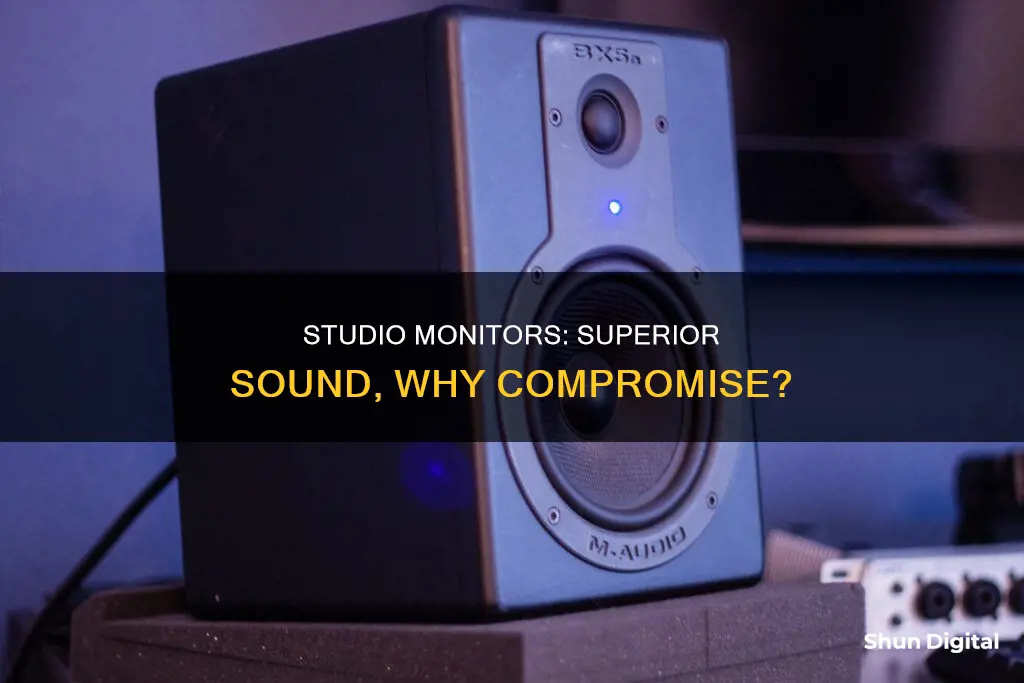
Studio monitors and regular speakers may look similar, but they are designed for different purposes and have distinct characteristics. Studio monitors are used for critical listening in studio setups, allowing producers and engineers to identify and fix sonic imperfections in recordings. On the other hand, regular speakers are designed for casual listening and general entertainment purposes, enhancing the audio experience by boosting bass, mids, or treble and adding spatial effects. Studio monitors are designed to produce a flat frequency response, resulting in an accurate and uncoloured sound, while regular speakers modify the audio frequency to make it sound more pleasing to the listener.
| Characteristics | Values |
|---|---|
| Purpose | Studio monitors are used for critical listening, recording, mixing, and mastering. Regular speakers are used for casual listening or general entertainment purposes. |
| Sound | Studio monitors are designed to produce accurate, true-to-life sound quality with a flat frequency response. Regular speakers are designed to sound good, enhancing the listening experience with effects like reverb and boosting bass, mids, or treble. |
| Active/Passive | Studio monitors are typically active, with built-in power amplifiers. Regular speakers are generally passive, requiring power from a dedicated standalone amplifier. |
| Power Amplifiers | Studio monitors have multiple power amplifiers in one unit, with individual amplifiers for each frequency. Regular speakers usually have only one power amplifier. |
| Crossovers | Studio monitors use crossovers to split frequencies and ensure they go to the right driver, adding clarity and precision. |
| Configuration | Studio monitors are often active speakers that don't need an external amplifier. Regular speakers are usually passive and require an external amplifier. |
| Range | Studio monitors are for near-field usage, sounding best when the listener is close to the source. Regular speakers are typically mid-to-far-field range, sounding better when listened to from a distance. |
| Design | Studio monitors are compact and designed for tighter spaces. Regular speakers often have sleek aesthetics to blend with home setups or look like furniture. |
| Accessibility | Studio monitors are geared towards professionals and may not be accessible to all music lovers due to their pro-level intricacies. |
What You'll Learn
- Studio monitors are designed for critical listening, while regular speakers are for casual listening
- Studio monitors are used to unveil every detail so the engineer can provide the best mix, while regular speakers are designed for the best listening experience
- Studio monitors have a flat frequency response, while regular speakers have a predetermined frequency setting
- Studio monitors are mostly active, with multiple built-in power amplifiers, while regular speakers are mostly passive
- Studio monitors are for near-field usage, sounding best when you're close to the source, while regular speakers are usually mid-to-far-field ranges

Studio monitors are designed for critical listening, while regular speakers are for casual listening
Studio monitors and regular speakers may look similar, but they are designed for different purposes and behaviours. Studio monitors are designed for critical listening, while regular speakers are for casual listening.
Studio monitors are used in the recording, mixing, and mastering process. They are meant to sound "bad" in the sense that they are designed to highlight sonic imperfections so that they can be fixed. Studio monitors have a flat, precise sound, meaning they do not emphasise any one frequency. This gives the user an accurate impression of their mix, allowing them to easily identify imperfections. Studio monitors are also active speakers, meaning they have built-in power amplifiers. This allows for multiple power amplifiers in one unit, powering the woofer (bass), midrange, and tweeter (treble) cones individually, resulting in a more precise sound.
Regular speakers, on the other hand, are meant to sound "good" with any sound and in any space. They are designed for casual listening and to provide an enjoyable and immersive listening experience. Regular speakers often have enhanced bass or treble to create a more appealing listening experience. They are typically passive speakers, receiving power from a dedicated standalone amplifier.
The key difference between the two is that studio monitors are designed for critical listening and accuracy, while regular speakers are designed for casual listening and an enjoyable audio experience. Studio monitors are used to identify and fix imperfections in music production, while regular speakers are used for consuming audio products.
Finding Ports Using Resource Monitor: A Step-by-Step Guide
You may want to see also

Studio monitors are used to unveil every detail so the engineer can provide the best mix, while regular speakers are designed for the best listening experience
Studio monitors and regular speakers may look similar, but they are designed for different purposes and behave differently. Studio monitors are used to unveil every detail so the engineer can provide the best mix, while regular speakers are designed for the best listening experience.
Studio monitors are used in studio setups for critical listening. They are designed to have a flat frequency response, meaning they do not amplify or boost any frequencies. This results in an accurate, true-to-life sound without any coloration or distortion. Studio monitors are ideal for music production, audio production, and professional studio recording as they allow for precise adjustments to achieve the desired sound. They are also used for critical listening, recording, mixing, and mastering, as they enable producers to hear every detail in the music.
Regular speakers, on the other hand, are designed for general and casual listening or entertainment purposes. They deliver an enhanced and modified audio experience by boosting bass, mids, or treble frequencies and adding spatial effects like reverb. Regular speakers are meant to sound good in any space and provide a dynamic sound experience for music, movies, or TV shows. They are typically used in home setups, such as living rooms, home theatres, or personal spaces.
The technical differences between studio monitors and regular speakers include active/passive functionality, individual power amplifiers, crossovers, and sound profile. Studio monitors tend to be active, with built-in power amplifiers, while regular speakers are usually passive, receiving power from a dedicated external amplifier. Studio monitors have multiple power amplifiers in one unit, with individual power for the woofer (bass), midrange, and tweeter (treble) cones, resulting in a more precise sound.
Additionally, studio monitors are designed for near-field usage, meaning they sound best when the listener is close to the source. In contrast, regular speakers are typically mid-to-far field ranges, sounding better when listening from a distance. Studio monitors are compact and designed for tighter spaces, while regular speakers often have sleek aesthetics to blend with home decor.
Removing FPS Counter: A Guide for ASUS Monitor Users
You may want to see also

Studio monitors have a flat frequency response, while regular speakers have a predetermined frequency setting
Studio monitors are designed to have a flat frequency response, meaning that all frequencies are played at the same volume level. This is in contrast to regular speakers, which have a predetermined frequency setting built-in that distorts or amplifies certain sounds, changing the way a sound is heard through the speaker.
Regular speakers are designed to emphasise certain frequencies to create a more appealing sound for the listener. For example, they may add more bass to music or boost treble frequencies to make the music sound crisp and clear. Studio monitors, on the other hand, aim for a flat frequency response to give a true representation of the sound, ensuring accurate mixing and mastering.
This flat frequency response means that studio monitors do not amplify any frequencies, such as bass or treble. Instead, they leave the sound wave untouched, allowing producers and editors to hear the sound in its raw form. This is crucial for audio production, as it allows them to make informed decisions about the audio without any enhancements or limitations imposed by the speaker.
The flat frequency response of studio monitors also ensures that all frequencies are played at the same volume level, which is important for mixing. If a speaker boosts certain frequencies, it can trick the listener into thinking the mix is well-balanced when it is not. With a flat frequency response, studio monitors provide an accurate impression of the mix, allowing for easy identification of imperfections.
In summary, studio monitors have a flat frequency response, meaning they play all frequencies at the same volume level and do not amplify or distort any frequencies. This is in contrast to regular speakers, which have a predetermined frequency setting that alters the sound to make it more appealing to listeners. The flat frequency response of studio monitors is crucial for accurate audio production and mixing.
Monitoring Hydro Usage: Smart Metering and Water Efficiency
You may want to see also

Studio monitors are mostly active, with multiple built-in power amplifiers, while regular speakers are mostly passive
Studio monitors are active speakers, meaning they have built-in amplifiers. This makes them simpler to use and set up, as all the components are included inside the cabinet. However, this also means that they are heavier and may be difficult to mount on walls or ceilings. They also require a power cable, in addition to an audio cable.
Regular speakers, on the other hand, are mostly passive, meaning they require external power from a dedicated standalone amplifier. This gives them more flexibility, as you can choose your own amplifier and create your ideal signal chain. They are also lighter and easier to mount, requiring only a standard speaker cable.
Studio monitors, with their built-in amplifiers, offer a more precise sound. Individual power amplifiers mean that the woofer (bass), midrange and tweeter (treble) cones are each powered individually. This, along with the use of crossovers, adds clarity and precision to the sound, allowing you to hear every detail across the EQ range.
The multiple built-in power amplifiers of studio monitors make them superior to regular speakers for critical listening and picking out sonic imperfections during the recording, mixing and mastering process.
A Simple Guide to Remove Lines on Your ASUS Monitor
You may want to see also

Studio monitors are for near-field usage, sounding best when you're close to the source, while regular speakers are usually mid-to-far-field ranges
Studio monitors and regular speakers differ in their intended use and design, with studio monitors being superior for near-field usage and sounding best when the listener is close to the source.
Studio monitors are designed for near-field use, which means they are meant to be placed within a few feet of the listener. This close proximity delivers a clear and immediate sound, free from the impact of room acoustics and natural reverberations. The sound produced by studio monitors is flat and precise, without emphasising any particular frequency. This is intentional, as it allows for critical listening and the identification of sonic imperfections during the recording, mixing, and mastering process. Studio monitors are also active speakers, with built-in power amplifiers, and often have multiple amplifiers in a single unit, resulting in a more precise sound.
Regular speakers, on the other hand, are typically designed for mid-to-far-field usage. They are meant to sound good in any room and from any direction. These speakers usually have predetermined frequency settings that amplify certain sounds, enhancing the listening experience for consumers. Regular speakers are passive, receiving power from a dedicated external amplifier.
The differences in design and functionality between studio monitors and regular speakers make studio monitors ideal for near-field usage and critical listening, while regular speakers are better suited for mid-to-far-field ranges and delivering an enjoyable listening experience.
Connecting Dual Monitors: DVI Cable Setup Guide
You may want to see also
Frequently asked questions
Studio monitors are designed to have a flat frequency response, meaning they do not amplify or boost any frequencies such as bass or treble. This results in an accurate, true-to-life sound quality, which is crucial for music production, as it allows producers to identify and fix any imperfections in the mix.
Studio monitors are primarily used for critical listening in studio setups, allowing producers to create an accurate and transparent audio representation. On the other hand, regular speakers are designed for casual listening or general entertainment purposes, enhancing the listening experience by boosting certain frequencies and adding effects like reverb.
Studio monitors are typically active speakers, meaning they have built-in power amplifiers. They often have multiple power amplifiers in one unit, allowing individual control of the woofer, midrange, and tweeter (treble) cones for a more precise sound. Regular speakers, on the other hand, are usually passive and require an external amplifier.
While studio monitors are ideal for music production, regular speakers are designed to provide an enhanced listening experience for music, movies, or TV shows. They can boost bass, mids, or treble and add spatial effects, making them suitable for home entertainment systems or personal listening setups.







